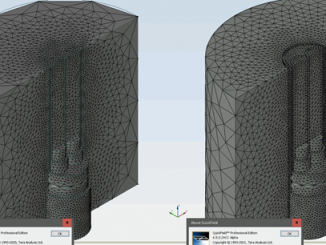Factory testing of a pioneering superconducting generator for hydroelectric applications from GE Power Conversion business has demonstrated a high correlation between the accuracy of the Opera electromagnetic simulation tool used during the design process, and the performance of the finished product. The proven fidelity of the simulation, for such a complex electrical machine with 28 poles, could help GE to create advanced solutions for numerous emergent superconducting applications in markets such as wind, wave and hydroelectric power generation, and electric motors for ship propulsion.
 The testing results were for the Hydrogenie generator for hydroelectric applications, which was developed by a team from GE and partners, with financial support from the EU. The generator employs high temperature superconducting (HTS) wire, to provide both a step increase in output efficiency, and size and weight reductions of some 70 percent when compared to a conventional electrical machine.
The testing results were for the Hydrogenie generator for hydroelectric applications, which was developed by a team from GE and partners, with financial support from the EU. The generator employs high temperature superconducting (HTS) wire, to provide both a step increase in output efficiency, and size and weight reductions of some 70 percent when compared to a conventional electrical machine.
The correlation between predicted and measured results is extremely close. For example, the Opera finite element design tool from Cobham Technical services predicted the efficiency of the machine to an accuracy within 0.1 percent of the final built product. This has many potential advantages for the electrical machine developers at GE.
As this was GE Power Conversion’s first venture into HTS generator engineering, the development team employed conservative rules to create a machine capable of meeting the target output figure of 1.7 MW. The conservatism ensured that the machine would meet the real-world specification. However, the new factory tests have shown that the generator is actually capable of providing considerably more output power than the target figure. Consequently, now that the accuracy of the simulator has been proven, GE developers are confident that the Opera simulator will help engineers to create cost-effective superconducting models for future applications.
“Testing proves that our superconducting generator design ideas work well, but also that we can predict performance with very good accuracy. Being able to produce very lean superconducting models, that are even more compact and perfectly matched to the application, could really make a big difference in the cost effectiveness of projected future applications such as wind power,” said Martin Ingles, Hydrogenie project manager at GE Power Conversion.
During the development and testing cycle, the engineers at GE also compared the finite element electromagnetic design approach with its own suite of analytical programs for generators, which have been developed and refined over many years at the company’s Rugby site. The finite element approach provided considerably more accurate predictions for some parameters, as well as offering the ability to accurately evaluate new mechanical shapes and geometries without modifying the underlying formulas. This versatility was particularly helpful for the new superconducting generator development as it features an unusual airgap and pole layout.
In addition to accurate predictions, the Opera simulator also provided the platform for GE to optimize the generator development before construction. As part of its work for this EU-funded project Cobham modified its software to make it simpler to simulate very large electrical machines with lots of poles – by extending its support for two-dimensional (2D) simulation of segments of a symmetric radial structure to 3D structures. As a result, GE was able to analyze hundreds of concepts during the development process, using partial 2D and 3D simulations, before settling on the detail of the final architecture and then fine tuning the performance with the aid of very detailed 3D analysis.
“The very fine resolution of electromagnetic modeling that’s possible using the Opera simulator, combined with the proven high accuracy of simulation, gives users complete freedom to explore new architectural concepts – in a way that is not feasible with many traditional analytical programs,” added Cobham’s Chris Riley. “This design tool support is ideal for this branch of superconducting applications, which will be very reliant on design innovation for success.”
The resulting Hydrogenie machine has an efficiency of more than 98 percent, which is very high for a relatively small output (1.7 MW) generator of this type, which is optimized for a run-of-river hydroelectric application operating at rotational speeds up to 214 RPM.
The generator itself has a conventional stator. The rotor’s salient poles of laminated iron operating at room temperature are surrounded by HTS field coils cooled to below 40 K. The rotor is surrounded by a copper shield, which also acts as the outer wall of the vacuum vessel containing the rotor as well as a damper winding. The coils are thermally insulated from the poles by a combination of the vacuum and multi-layer insulation. The coils are cooled by helium gas circulated through a cryogenic transfer coupling between the stationary and rotating structure.
The Hydrogenie project experience is very valuable for Cobham, who have used the knowledge to integrate new features into the Opera software package. These new features join a growing suite of utilities that simplify high temperature superconductor development, including the industry’s first commercial tool for analyzing the superconducting ‘quenching’ process, and special modeling features to simplify design using HTS wire materials with their non-linear properties – developed in conjunction with Sumitomo.
The partners in the Hydrogenie project were the overall project leader and coordinator GE Power Conversion (formerly Converteam), plus EOn Wasserkraft, Zenergy Power (formerly Trithor), Stirling Cryogenics, KEMA, Silesian University of Technology, and Cobham Technical Services who provided the design software.



